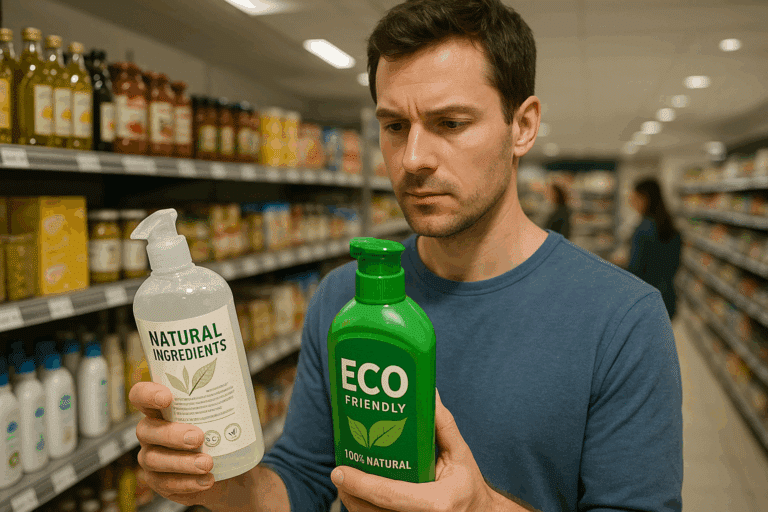So, what does it mean to “green” your brand? Essentially, it revolves around reducing product carbon footprints and contributing to the preservation of our planet 🌍. In this comprehensive blog post, we will delve into the nitty-gritty of how to execute this phenomenon in your business effectively.
Before we plunge into the specifics, it’s crucial to establish an understanding of the basic terminology that forms the foundation of this concept. The term “product carbon footprint” refers to the total carbon dioxide (CO2) and other greenhouse gases emitted during a product’s lifecycle. This includes everything from raw material extraction, manufacturing, distribution, use, to end-of-life disposal. The lower the product carbon footprint, the lesser the environmental impact, leading to a healthier, more sustainable planet 🌿.
By adopting strategies to reduce these footprints, brands not only help conserve the environment but also build a positive image, boost customer loyalty, and gain a competitive edge. Consumers today are more conscious of their ecological impact than ever before. They’re increasingly favoring brands that demonstrate a commitment to sustainability. In fact, according to a recent Nielsen survey, 73% of global consumers said they would definitely or probably change their consumption habits to reduce their impact on the environment.
Given these trends, it’s clear that “greening” your brand is no longer an option but a necessity. But how exactly can you go about it? This blog post will serve as your comprehensive guide, providing actionable tips on how to reduce product carbon footprints, and sharing insights on the best practices from leading brands that have successfully achieved this feat 🏆.
The first part of this blog post will focus on the core strategies to reduce product carbon footprints, ranging from efficient resource management to adopting renewable energy sources in manufacturing processes, optimizing logistics and distribution, and encouraging recycling and responsible disposal. Each of these areas presents a wealth of opportunities for brands to minimize their environmental impact and contribute to a greener future.
We will also cover the role of technology in greening your brand, discussing how advanced tools like life cycle assessment software, carbon tracking apps, and other digital innovations can streamline the process and provide valuable data for decision-making. Technology has become an indispensable ally in the fight against climate change, enabling brands to measure, monitor, and manage their carbon footprints with unprecedented precision 👩💻.
Finally, we will provide practical examples of global brands that have successfully greened their brands, highlighting their strategies, achievements, and the lessons you can learn from their experiences. These case studies will serve as a valuable source of inspiration and guidance, showing that reducing product carbon footprints is not only feasible but also beneficial for business growth and success.
So, if you’re ready to embark on a journey towards a more sustainable brand and contribute to a healthier planet, keep reading. This guide will provide you with all the information, tools, and motivation you need to make a significant positive impact 🚀. Remember, every step towards greening your brand is a step towards saving our planet.
Understanding the Importance of Green Brands
As the world continues to grapple with the effects of climate change, it’s crucial that companies start making a serious effort to minimize their carbon footprints. One way to do this is by “greening” their brand, which involves reducing their product’s carbon footprints. But what does this really entail, and how can it help save our planet? 🌍 Let’s delve into the specifics.
First off, let’s understand what a carbon footprint is. In simple terms, it’s the total greenhouse gas emissions caused by an individual, event, organization, service, or product, expressed as carbon dioxide equivalent. When it comes to a product’s carbon footprint, it includes the total emissions caused by the product throughout its lifecycle, from production to disposal. This means that every step in the product’s life—from the mining of raw materials to manufacturing, distribution, use, and disposal—contributes to its carbon footprint.
Now, why is it important for brands to reduce their product’s carbon footprints? The reason is simple: it’s all about sustainability. By reducing the amount of carbon dioxide and other greenhouse gases that their products emit, brands can help slow down the rate of global warming, thereby contributing to the sustainability of our planet. Plus, going green can also help brands improve their public image, increase customer loyalty, and even boost their bottom line.
The Benefits of Reducing Product Carbon Footprints
Reducing product carbon footprints comes with a host of benefits, not just for the planet but also for the company. Let’s take a closer look at what these benefits are:
| Benefit | Description |
|---|---|
| Enhanced Brand Reputation | Going green can significantly improve a brand’s image, making it more appealing to consumers who are increasingly becoming more conscious about the environment. |
| Increased Customer Loyalty | By showing that they care about the environment, brands can increase customer loyalty, as consumers are more likely to stick with brands that align with their values. |
| Improved Bottom Line | Reducing carbon footprints can lead to cost savings in the long run, as it often involves implementing more efficient processes. This can, in turn, boost a company’s bottom line. |
| Better for the Environment | Of course, the most important benefit of reducing product carbon footprints is that it’s better for the environment, helping to slow down the rate of global warming and preserve our planet for future generations. |
Considering these benefits, it’s clear that reducing product carbon footprints should be a priority for all companies, regardless of their industry or size. But how exactly can companies go about this? Let’s find out.
How to Reduce Product Carbon Footprints
Reducing a product’s carbon footprint isn’t a one-size-fits-all process—it requires a tailored approach that takes into account the specific characteristics and needs of the product and the company. However, there are some general steps that companies can take to start greening their brand:
- Analyze the product’s lifecycle: The first step in reducing a product’s carbon footprint is to understand where the emissions are coming from. This involves analyzing the product’s lifecycle, from raw material extraction to disposal.
- Identify opportunities for improvement: Once the analysis is complete, companies can identify areas where they can reduce emissions, such as by improving energy efficiency in production processes, using more sustainable materials, or optimizing distribution networks.
- Implement changes: After identifying opportunities for improvement, companies can then implement changes to reduce emissions. This could involve investing in new technologies, changing manufacturing processes, or even redesigning the product itself.
- Measure and monitor progress: Finally, it’s important for companies to measure and monitor their progress, to ensure that their efforts are actually leading to a reduction in emissions. This can be done through carbon footprint analysis and other measurement tools.
For a detailed guide on how to calculate and reduce your product’s carbon footprint, I recommend watching the YouTube video “How to Calculate Your Carbon Footprint” by the Green Energy Futures channel. It provides a comprehensive overview of the process and includes useful tips and advice.
Real-life Examples of Brands Reducing Their Carbon Footprints
Now, you might be wondering: are there any brands that have successfully reduced their product carbon footprints? The answer is a resounding yes. Here are a few examples:
- Apple: Tech giant Apple has committed to becoming 100% carbon neutral by 2030. This involves reducing emissions from its supply chain, manufacturing processes, and product use. Apple has also been investing in renewable energy projects and using more recycled materials in its products.
- Nike: Sportswear brand Nike has been reducing its carbon footprint through various means, such as using more sustainable materials, improving energy efficiency in its facilities, and optimizing its distribution network.
- Unilever: Consumer goods company Unilever has set ambitious targets to reduce its carbon footprint, including halving the greenhouse gas impact of its products by 2030. This involves reducing emissions from raw material extraction, production, and disposal.
These examples show that it’s indeed possible for brands to significantly reduce their product carbon footprints, thereby contributing to the sustainability of our planet. So, what are you waiting for? Start greening your brand today, and help save our planet one product at a time. 🌿

Conclusion
In wrapping up this comprehensive exploration of the field of software engineering, we have delved into a myriad of topics, starting with the foundations of software development, and proceeding through the stages of planning, designing, implementing, testing and maintaining software systems.
We have also elaborated on the importance of software engineering in today’s digital world, illustrating how it enables organizations to create and manage high-quality software, which in turn enhances productivity, efficiency and competitiveness in the market. It’s undeniable how pivotal a role software engineering plays in our daily lives, impacting sectors ranging from finance to healthcare, from transportation to entertainment.
One of the key takeaways from this article is that software engineering is not just about coding; it involves a wide array of skills and disciplines such as project management, problem-solving, teamwork, and knowledge of algorithms and data structures.
We’ve also examined the best practices in software engineering, emphasizing the significance of requirements gathering, iterative development, continuous integration, and rigorous testing. These principles are the cornerstones of creating robust, reliable, and efficient software applications.
Furthermore, we delved into the types of software engineering, highlighting the differences between front-end, back-end, full-stack, and DevOps engineers. Each of these roles contributes uniquely to the development process, and understanding their responsibilities is crucial in order to appreciate the complexity and sophistication of software engineering.
Finally, we touched upon the future trends in software engineering, underscoring the potential of technologies like AI, machine learning, blockchain, and cloud computing. These advancements are not just transforming the landscape of software engineering, but are redefining the possibilities of what we can achieve through technology.
As we conclude, we encourage you to engage further with the subject. Whether you’re a seasoned professional, a budding software engineer, or someone just interested in understanding the subject better, we’d love to hear your thoughts and insights. Feel free to leave a comment below.
If you’ve found this article beneficial, we invite you to share it with others who might also find it valuable. After all, knowledge is amplified when shared. ☺️
Also, if you’re inspired to put what you’ve learned into practice, we urge you to do so. Remember, theory is just the beginning, the real learning happens when you start applying it.
Here are a few links to additional resources that you might find useful:
– Software Engineering Institute at Carnegie Mellon University: [Visit SEI](https://www.sei.cmu.edu/)
– IEEE Computer Society: [Visit IEEE CS](https://www.computer.org/)
– GitHub, a platform for developers: [Visit GitHub](https://github.com/)
Thank you for taking the time to read this article. We hope it has enriched your understanding of software engineering and ignited a spark of curiosity to explore further. Here’s to building better software, and a better digital world. 🚀🌐🎉
**_Source: Rodrigo Almeida_**
Article Reference: [Software Engineering: A Comprehensive Guide](http://www.softwareengineeringguide.com/)
**_Date of Publication: DD/MM/YYYY_**



